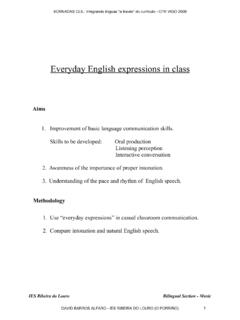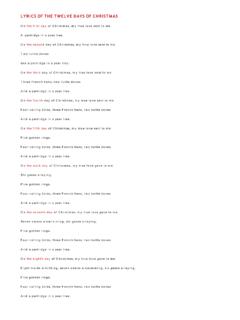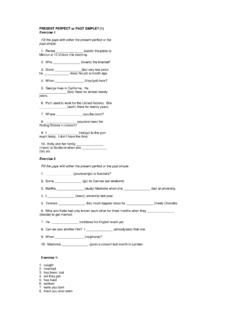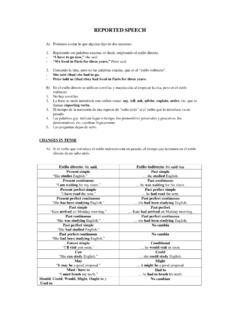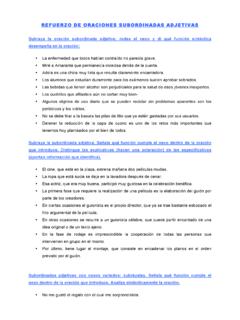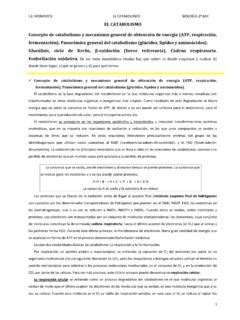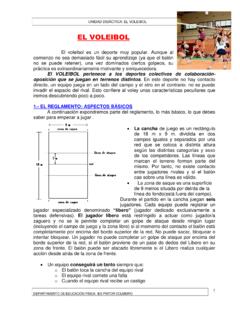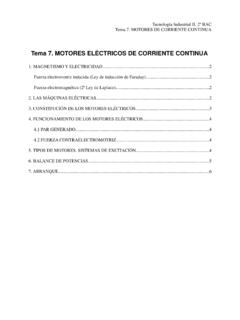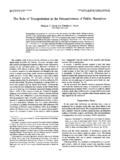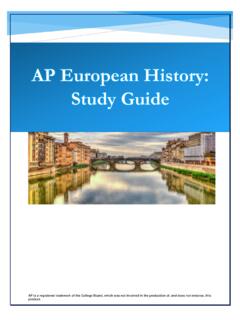Transcription of Reported Speech
1 Reported Speech A) Podemos contar lo que alguien dijo de dos maneras: 1. Repitiendo sus palabras exactas, es decir, empleando el estilo directo. - I have to go now, she said. - We lived in Paris for three years, Peter said. 2. Contando la idea, pero no las palabras exactas, que es el estilo indirecto . - She said (that) she had to go. - Peter told us (that) they had lived in Paris for three years. B) En el estilo directo se utilizan comillas y may sculas al empezar la cita, pero en el estilo indirecto: 1. No hay comillas. 2. La frase se suele introducir con verbos como: say, tell, ask, advise, explain, order, etc, que se llaman reporting verbs.
2 3. El tiempo de la narraci n da una especie de salto atr s si el verbo que lo introduce va en pasado. 4. Las palabras que indican lugar o tiempo, los pronombres personales y posesivos, los demostrativos, etc, cambian l gicamente. 5. Las preguntas dejan de serlo. CHANGES IN TENSE A) Si el verbo que introduce el estilo indirecto est en pasado, el tiempo que ten amos en el estilo directo da un salto atr s. Estilo directo: He said, Estilo indirecto: He said that Present simple She studies english . Past simple .. she studied english . Present continuous I am waiting for my sister. Past continuous .. he was waiting for his sister.
3 Present perfect simple I have read the note. Past perfect simple .. he had read the note. Present perfect continuous She has been studying english . Past perfect continuous .. she had been studying english . Past simple Kate arrived on Monday morning. Past perfect .. Kate had arrived on Monday morning. Past continuous She was studying english . Past perfect continuous .. she had been studying english . Past perfect simple She had studied english . No cambia Past perfect continuous She had been studying english . No cambia Future simple I ll visit you soon. Conditional .. he would visit us soon. Can She can study english .
4 Could .. she could study english . May It may be a good proposal. Might .. it might be a good proposal. Must / have to I must brush my teeth. Had to .. he had to brush his teeth. Should, Could, Would, Might, Ought to y Used to No cambian B) Estos cambios no ocurren: 1. Cuando el verbo que introduce la cita est en presente o en futuro. - I love soup, says Mary. - Mary says she loves soup. 2. Cuando se narra una verdad objetiva o una situaci n permanente. - London is the capital of Great Britain, she pointed out. - She pointed out that London is the capital of Great Britain. C) Otros cambios necesarios al pasar una frase a estilo indirecto son: 1.
5 Los pronombres personales y los adjetivos o pronombres posesivos de 1 y 2 persona cambian seg n quien habla, pero los de 3 persona no cambian. - I am waiting for my sister, Bill said. - Bill said (that) he was waiting for his sister. 2. Las expresiones de tiempo y de lugar. now then today / tonight that day / that night yesterday the day before, the previous day tomorrow the next / following day, the day after next week / month the following week / month last week / month the previous week / month, the week / month before a week / month ago the week / month before here there 3. Los demostrativos this that these those REPORTING COMMANDS, REQUESTS, WARNINGS, INVITATIONS, ETC Las rdenes se suelen expresar en imperativo pero al ponerlas en estilo indirecto: 1.
6 El imperativo pasa a infinitivo manteniendo la forma afirmativa o negativa. - He said, Go away, Mary! He ordered Mary to go away. - She said, don t open the door. She told me not to open the door. 2. El verbo que introduce el estilo indirecto debe indicar mandar , pedir , rogar , invitar , advertir , etc, por eso nunca se usa say (decir), sino tell, ask, order, beg, invite, warn, que deben llevar un complemento de persona, a quien se da la orden, se le pide, se le invita, etc. - He said, Be quiet. He told us to be quiet. - She said, Please don t shout.
7 She asked me not to shout. Nota: Al traducir las rdenes en estilo indirecto usamos el subjuntivo - He told me to be quiet. (Me dijo que me callara.) REPORTING QUESTIONS PREGUNTAS DEL TIPO YES / NO 1. La pregunta se convierte en una frase y por tanto ya no hay inversi n de sujeto y verbo. - Did you speak to John last night? she asked. - She asked if / whether I had spoken to John the night before. 2. Desaparece el signo de interrogaci n. 3. Detr s del reporting verb se pone if o whether (pueden usarse indistintamente) PREGUNTAS CON PART CULA INTERROGATIVA (WH-QUESTIONS) Al poner en estilo indirecto este tipo de preguntas mantenemos la part cula interrogativa: what, who, where, when, how, why, etc, en lugar de poner if o whether.
8 - Who did you speak to last night? He asked who I had spoken to the night before. - Where are you working these days? He asked where she was working those days. Si la particular interrogativa es el sujeto de la pregunta, el orden de las palabras de la oraci n se mantiene igual. - Who told you this story? He asked who had told us that story. Los verbos m s frecuentes para introducir el estilo indirecto en preguntas son: ask, want to know, wonder, enquire SUGGESTIONS En estilo directo suelen expresarse de varias maneras: 1. Let - Let s go to the theatre, she said. 2. Why don t - Why don t we go to the theatre?
9 She said. 3. Shall - Shall we go to the theatre? she said. 4. Why - Why not go to the theatre? 5. What / How about ..? - What / How about going to the theatre? Para pasar una sugerencia (afirmativa o negativa) a estilo indirecto, la introduciremos con el verbo suggest, que puede ir seguido de: 1. un gerundio (muy frecuente) - She suggested going to the theatre. - Let s not argue again, he said He suggested not arguing again. 2. una oraci n subordinada introducida por that + we / they + (not) forma base del verbo (no es tan frecuente) - She suggested that we go to the cinema. - He suggested that they not argue again.
10 A) PUT THE FOLLOWING SENTENCES INTO Reported Speech : Where did you go on holiday last summer? I asked Linda. Do you know where Angela is living? he said. How much do you think it will cost? he said. Watch the milk and don t let it boil over, she said. Let s go down to the harbour and see if we can hire a boat, he said. Did you enjoy the film? I asked Tom. Can I borrow some money for a fizzy drink?
